Do Turtles Like To Hide?
Turtles are low-maintenance, long-lived, and generally quite docile creatures that make for great companions. But even though they’re easy to care for, turtles still have some very specific needs that must be met in order to keep them healthy and happy.
One of the most important aspects of a turtle’s routine is their hiding habits. Turtles are naturally shy creatures that like to stay hidden away from view. In the wild, turtles will spend most of their time hiding in burrows, under rocks, or in other dark, hidden places. In captivity, turtles still like to hide, but they don’t have the same options for hiding places that they do in the wild.
That is why it’s important to provide your turtle with a hiding place in their enclosure. A good hiding place will give your turtle a sense of security and help them feel more at home. Well, let us dig more into this topic.
Related Blog:
Why Turtles Might Choose to Hide?
One of the many reasons that turtles might choose to hide is to keep warm. Turtles are ectotherms, meaning they rely on external sources of heat to regulate their body temperature. So, when the weather outside is cold, turtles will often burrow into the mud at the bottom of their pond or lake in order to stay warm.
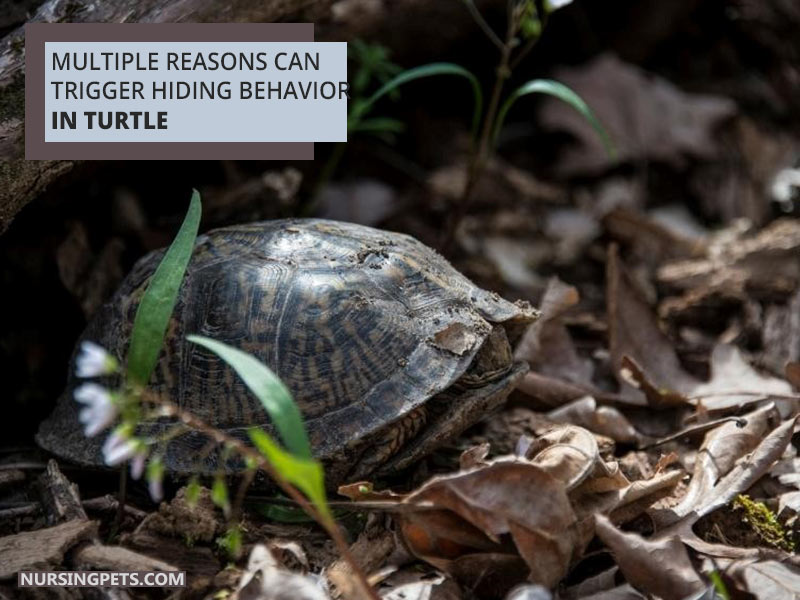
Another reason that turtles might choose to hide is to avoid predators. By hiding in the mud or under rocks, turtles can make it difficult for predators to spot them.
Finally, turtles might choose to hide simply to take a nap! Hiding in a dark and quiet place can help turtles feel safe and relaxed enough to fall asleep.
Why Does My Pet Turtle Hide Under Rocks?
As we have mentioned before, hiding is normal behavior for a turtle. And whether it’s a pet or a wild one. However, hiding under rocks can be stimulated due to environmental heat, as turtles are cold-blooded animals and prefer cooler temperatures.
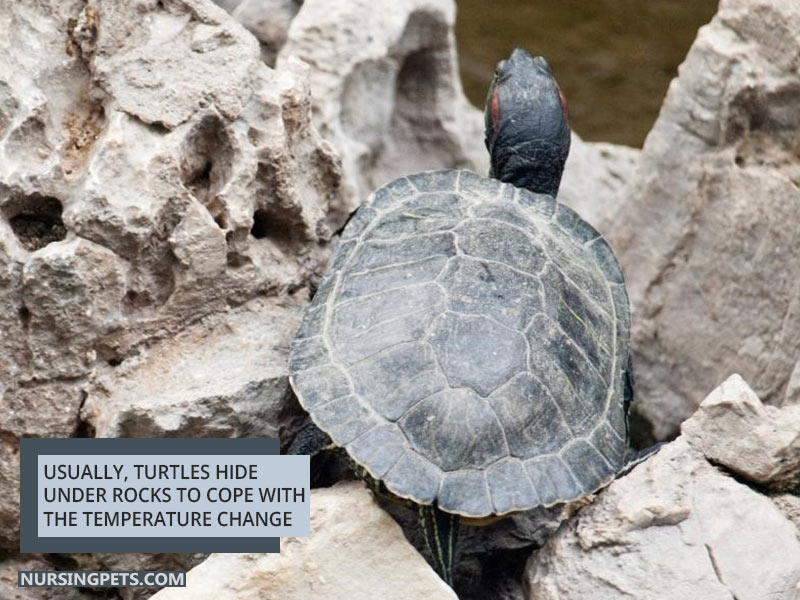
In a nutshell, turtles are ectotherms, meaning they rely on their environment to regulate their body temperature. If the temperature in the turtle’s enclosure is too warm, the turtle may hide under the rocks to cool down. Conversely, when the temperature is too cold, the turtle may hide under the rocks to stay warm.
It could also be that your turtle is trying to escape the light, as they are nocturnal animals and prefer darker environments. Additionally, it could be that your turtle is feeling stressed or scared and is seeking a safe place to hide.

Additionally, sometimes, pet turtle hides under rocks because it is sick or injured. And want to stay away from the outer world to rest and heal.
However, in the wild, turtles would hide under rocks or in caves to avoid predators and to rest during the day. But, this shouldn’t be the case for a turtle in captivity.
Do Turtles Hide Under Rocks When Stressed?
Turtles are not the only animals that hide under rocks when they are stressed. Other animals that hide under rocks include lizards, snakes, and frogs. When these animals are stressed, they often seek out a hiding place that is dark and quiet. This allows them to feel safe and secure while they rest and recuperate.
Hence, it’s not uncommon for turtles to seek refuge under rocks when they’re feeling stressed. This behavior is most likely a result of their natural instinct to avoid predators. By hiding under a rock, the turtle can make itself less visible and less likely to be attacked.
Why Does My Turtle Hide in The Corner?
Your turtle is likely hiding in the corner because it feels safe and secure there. Turtles are naturally shy and reclusive creatures, so being in a tight, enclosed space where predators or other animals can’t see them makes them feel more comfortable. If your turtle is healthy and happy, there’s no need to worry about its hiding habits.
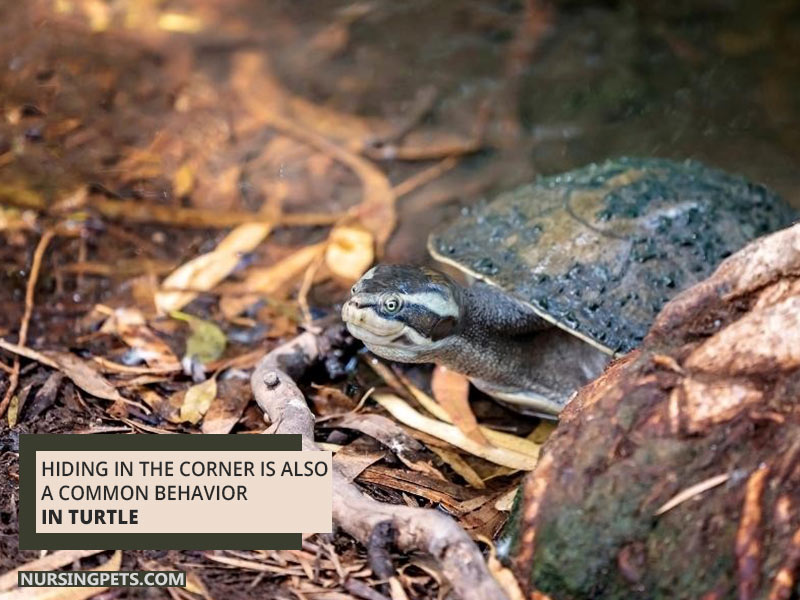
However, there could be other possible reasons for this behavior. To find the details, you can check out this article on turtles hiding in the corner.
Why Is My Turtle Always Hiding?
As we have mentioned, hiding is a normal behavior in turtles and some other reptile species. But, there is no reason for a turtle to hide all the time. But, if yours is? There is something going on. So, why is your turtle always hiding?
Well, are several reasons that can trigger this behavior. However, the most reasons are your turtle is feeling stressed or threatened, or it could be because the turtle is sick or injured. And sometimes, turtles do this when trying to stay cool or warm.
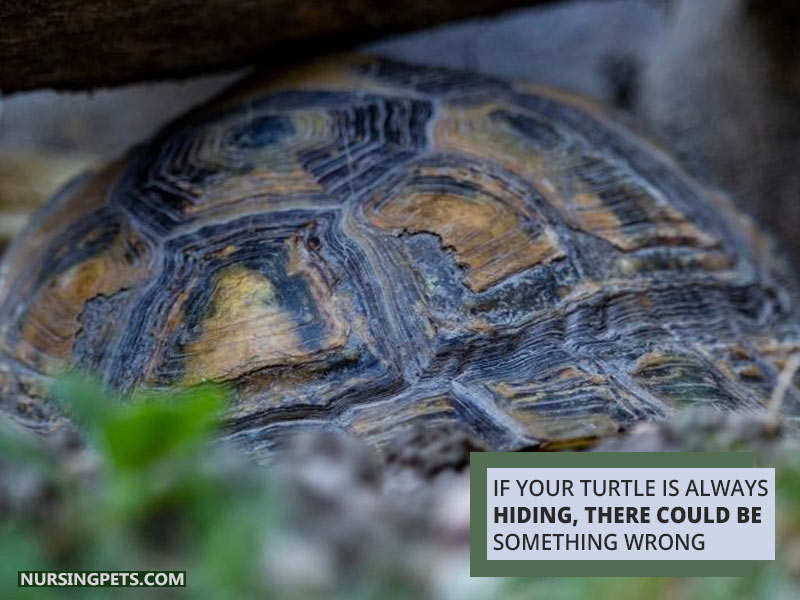
Moreover, your turtle maybe doesn’t feel comfortable in its environment and is looking for a place to feel safe. Otherwise, your turtle could also be hiding because it’s getting ready to lay eggs.
Therefore, if your turtle is female and has been hiding for a while, she might be ready to lay eggs. Once she lays her eggs, she’ll come out of hiding and return to her normal routine.
Why Is My Musk Turtle Hiding All The Time?
Musk turtles are shy, reclusive creatures that spend most of their time hiding in their shells. If your musk turtle is hiding all the time, it’s probably because it feels scared or threatened. Try to provide your turtle with a safe, secure environment where it can feel comfortable coming out of its shell.
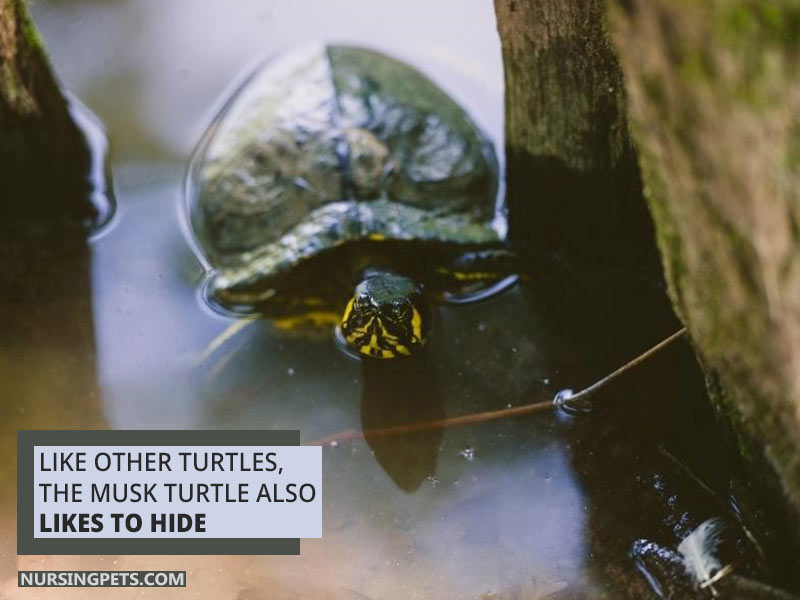
Another possibility is that it is not getting enough food. In case you have recently changed its food or the type of food it is getting, that could also be a factor. If you are using live food, make sure that the food is properly gutted and rinsed to avoid spreading bacteria or parasites to your turtle.
Other than these, the usual reasons for other turtle species can also be applied to the Musk turtle. Hence, find out the specific reason, and solve it. But if you can’t
Do Turtles Hide When They Are Dying?
No, turtles do not hide when they are dying. Instead, they may become more lethargic and stop moving around as much. Some turtles may also stop eating when they are close to death.
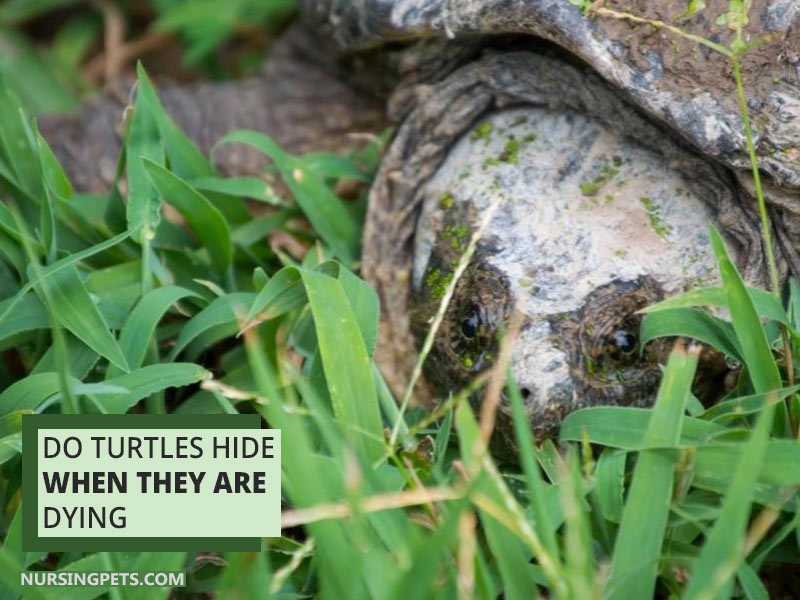
However, in some cases, when turtles are ill or dying, they will often hide away from view. This behavior is known as ‘throwing in the towel’ and is a way for turtles to conserve energy and avoid predation.
Where Do Turtles Like to Hide?
Turtles will often hide under rocks, in logs, or in the mud at the bottom of a pond. They will also burrow into the sand to make a nest for themselves. All of these places offer turtles a safe place to rest and avoid predators.
In a nutshell, turtles like to hide in the dark, warm places. However, if you are looking for a pet turtle, he or she may be somewhere dark and warm places.
Where Do Turtles Hide in A House?
Turtles are creatures of habit and will often return to the same hiding spots day after day. If you have a pet turtle, chances are you’ve found it hiding in some unexpected places around your house. Here are some of the most common places turtles like to hide:

Under furniture: Turtles often like to hide under furniture, especially if the one that is close to the ground. This provides them with a feeling of security and protection from predators.
In closets: Closets are another common hiding spot for turtles. This is likely because they are dark and quiet, which makes turtles feel safe.
In laundry baskets: Laundry baskets provide turtles with a soft, comfortable place to hide. They also offer the added bonus of being easy to access when the turtle wants to come out and explore.
In potted plants: Potted plants offer turtles both a hiding spot and a source of food (if the plants are edible). Turtles will also often use the dirt in the pot as a place to bury themselves.
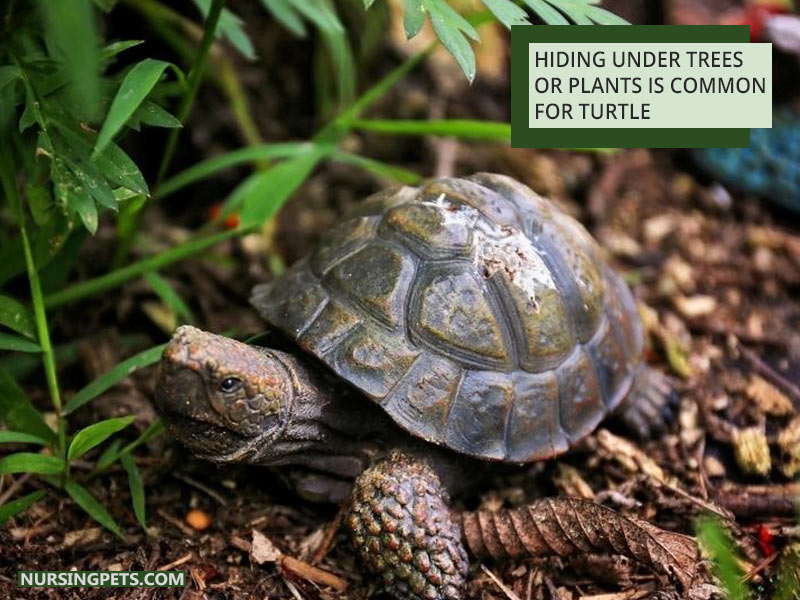
Under the bed: The space under the bed is often dark and quiet, making it an ideal hiding spot for turtles.
Under the sink: For a turtle, under the sink is an excellent place to hide. It is quiet, dark, and a good spot for hiding.
Do Turtles Need A Place to Hide?
Turtles are reptiles, and as such, they sometimes need a place to hide from the sun and predators. In the wild, turtles will find a place to hide under rocks or in the shade of trees. For your backyard, you can provide a turtle with a hiding place by placing a large rock or piece of wood in the garden.
On the other hand, turtles don’t necessarily need a place to hide; many species will burrow into the ground or hide under rocks or logs when the temperature gets too hot or when they feel threatened.
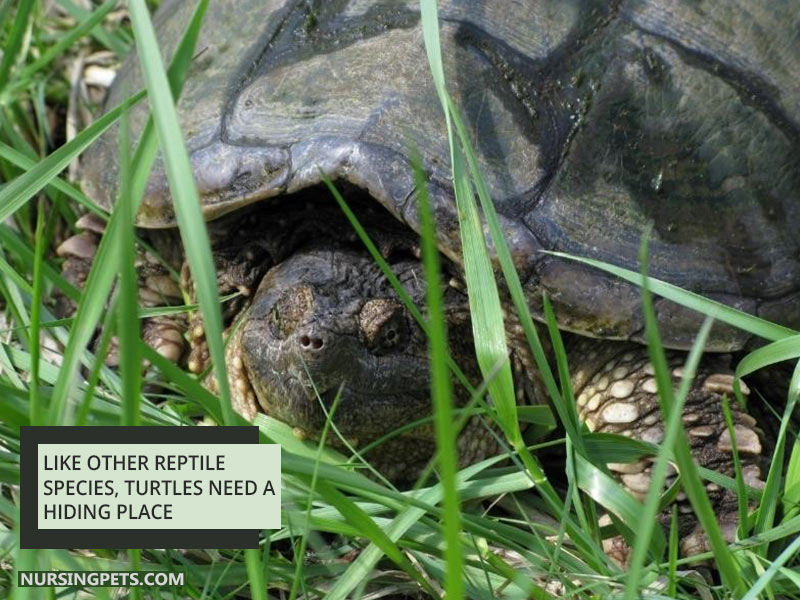
Some turtles, like the box turtle, even have a hinged shell that they can close up tightly to protect themselves from predators or the elements.
So, while turtles don’t necessarily need a place to hide, many species benefit from having a little shelter from time to time. And in certain cases, they may become stressed without a hiding place.
The Importance of Hiding Spots for Turtles
Hiding spots help turtles avoid predators, escape the heat of the sun or light, to rest in quiet, and find mates. They can be anything from a pile of leaves to a log in the water.
Turtles use their hiding spots for different purposes at different times of the year. In the spring and summer, when temperatures are warm, turtles often bask in the sun to raise their body temperature. But when the sun gets too hot, they’ll retreat to their hiding spots to stay cool.
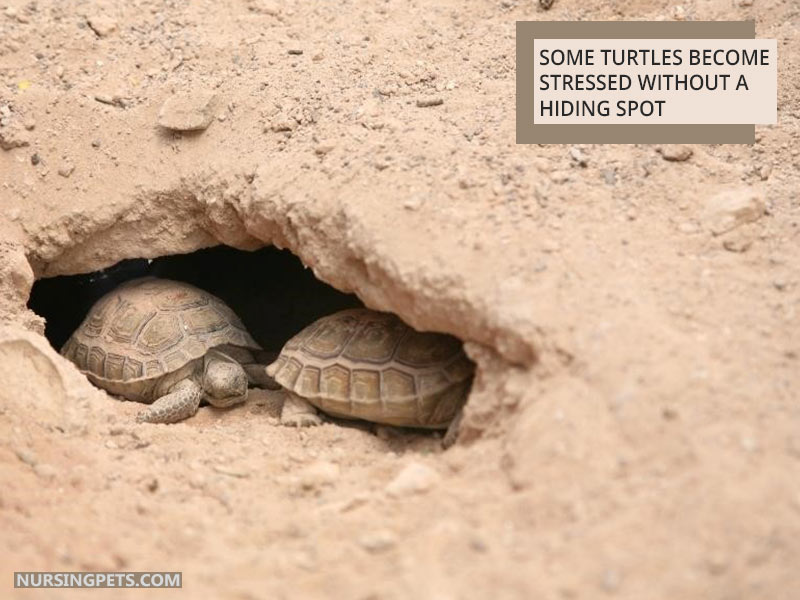
In the fall and winter, turtles hibernate in their hiding spots. During this time, they slow their metabolism and heart rate and can even breathe under the water.
When it’s time to mate, turtles leave their hiding spots in search of a mate. After mating, the female turtle will return to her hiding spot to lay her eggs.
Hiding spots are important for turtles at every stage of their lives. They offer protection from predators, the elements, and other turtles. Without a good hiding spot, a turtle would be vulnerable to attack and would have a hard time surviving.
How Do You Make A Hiding Place for A Turtle?
A hiding place for a turtle can be made out of many different things. Some people use old aquariums, Rubbermaid totes, or even PVC pipes. It really depends on the size of the turtle as to what will work best. If the turtle is smaller, then something like an old aquarium would work well.
If the turtle is larger, then something like a Rubbermaid tote would be a better option. PVC pipes can also be used, but they will need to be big enough for the turtle to fit into and turn around.
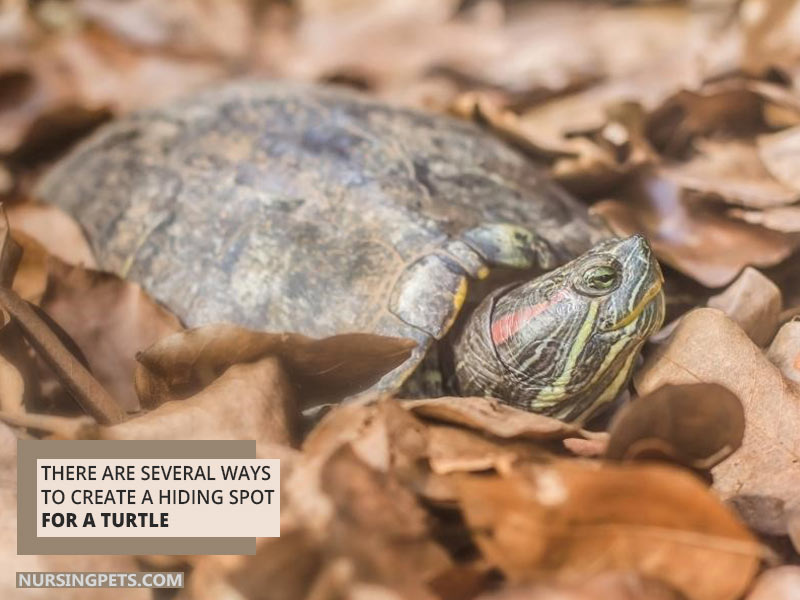
Turtles are shy creatures and like to have a place to hide when they feel threatened. So far, we have mentioned a few ways to give your turtle a hiding place.
However, to make things easier for you, here’s a step-by-step guide for you:
Step 1: Choose a suitable location for the hiding place. It should be quiet, away from foot traffic or other disturbance. Also, remember that your turtle will feel cramped and uncomfortable when the hiding place is too small. Alternatively, your turtle will feel exposed and vulnerable when it’s too large.
Step 2: Place a large, flat rock or piece of wood over the chosen spot. This will provide your turtle with a dark, sheltered area.
Step 3: Place some smaller rocks or pieces of wood around the large rock or piece of wood to further enclose the space and provide additional hiding places.
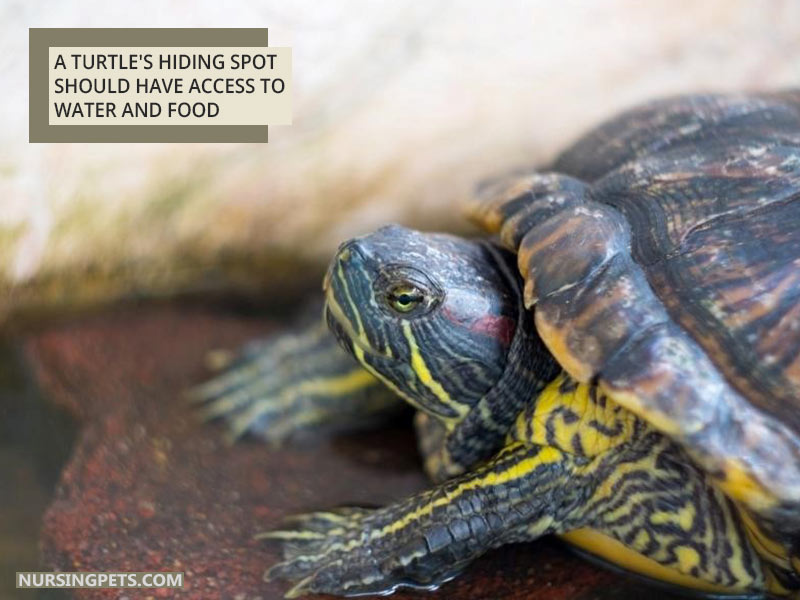
Step 4: Fill the hiding place with fresh, clean water.
Step 5: Place some live plants in the water. This will provide your turtle with additional hiding places and a source of food.
Another option is to create a hiding place out of rocks. It can be done by stacking rocks in a pyramid shape or by creating a cave out of rocks. Be sure to use stones that are smooth and have no sharp edges.
However, do not put the hiding place directly on the basking spot. That will make it too hot for your turtle and could cause them to overheat.
Your turtle will now have a safe, comfortable place to hide when it feels the need.
How Do You Get A Turtle to Come Out of Hiding?
Until now, we have discussed the benefits and necessity of hiding for a turtle. But what about if your turtle is hiding a lot, and you want to bring out him more to the open space? Well, you can also do something about that too.
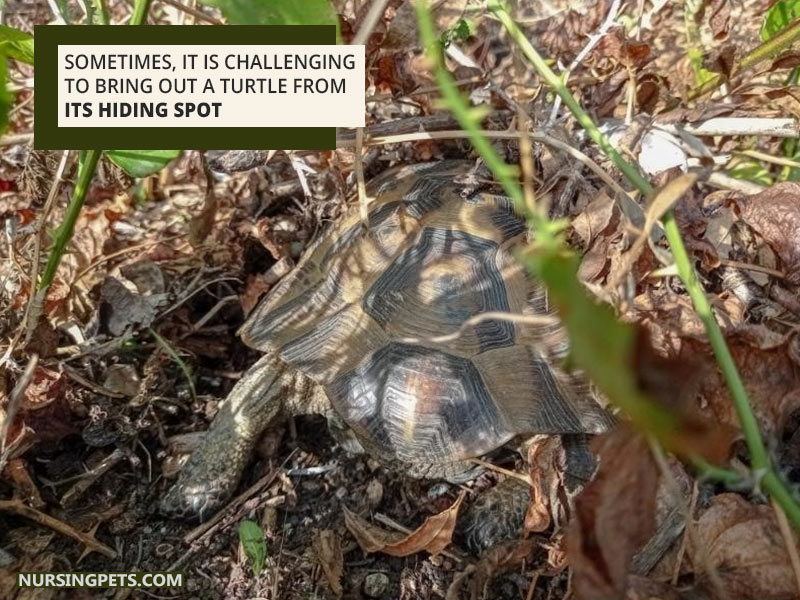
Although there isn’t a guaranteed way to get a turtle to come out of hiding, there are a few things you can try.
01. First, try to create a habitat that is as close to their natural environment as possible. This means providing plenty of hiding places, a basking area, and access to water.
02. Make sure the tank is at the right temperature. Turtles like it warm, so your turtle will want to stay hidden if the tank is too cold.
03. Check the food. Make sure there is enough food and that it is the right kind of food. Some turtles are picky eaters, so you may need to experiment to find the right food. You can also try offering them food in their hiding spot, as this may entice them to come out.
04. Try to make the tank more interesting. Add some new toys or decorations. This will give your turtle something to explore and may make it want to come out of hiding.
05. Be patient. If your turtle is healthy and the tank is at the right temperature, your turtle will eventually come out of hiding.
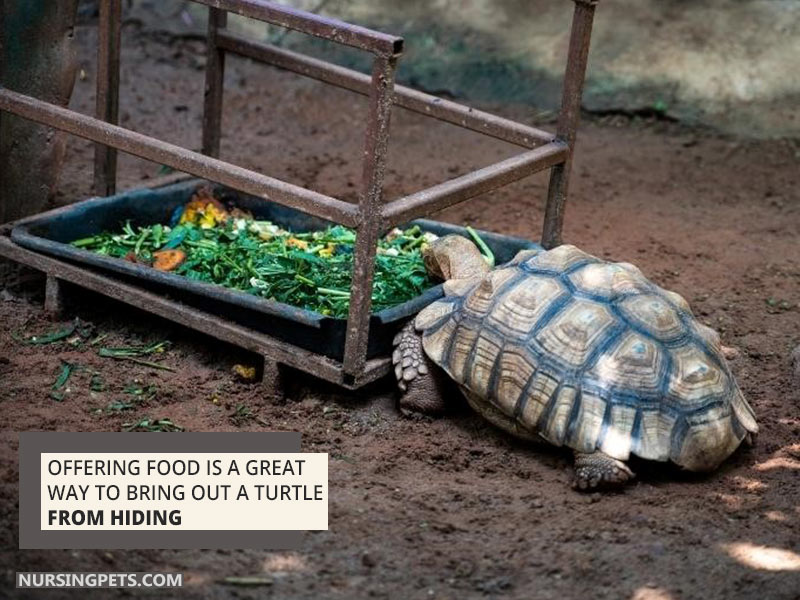
06. Check the area for any potential threats that might be causing the turtle to stay hidden. Once you’ve determined it’s safe, make some noise or movement near the area where you think the turtle is hiding. If all else fails, you may need to gently dig the turtle out.
In case your turtle is hiding more than usual, it could be a sign that something is wrong. Maybe your turtle is sick. Therefore, talking to a vet may help with that.
Do Sea Turtles Like to Hide?
Sea turtles are interesting creatures that spend most of their time in the water. But did you know that these turtles also like to hide?
It’s true! When sea turtles are not swimming, they often hide in the sand or among rocks. This helps them stay safe from predators and avoid being seen by humans.
So, if you’re ever looking for a sea turtle, be sure to check in all the nooks and crannies! You just might find one hiding in plain sight.
Take Away
It’s not uncommon to see a turtle basking in the sun or poking its head out of its shell, but turtles are just as happy hiding away. In the wild, turtles will often bury themselves in the sand or mud to escape predators or the hot sun.
Therefore, if you have a pet turtle, you might find it hiding under a rock or in a dark corner of its enclosure. Hiding is a natural behavior for turtles, so there’s no need to worry unless your turtle spends most of its time out of sight.
Image Source: Canva.com/photos

